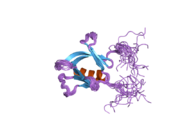Biology:PLEKHA6
From HandWiki
 Generic protein structure example |
Pleckstrin homology domain-containing family A member 6 is a protein that in humans is encoded by the PLEKHA6 gene.[1][2]
References
- ↑ "Identification of pleckstrin-homology-domain-containing proteins with novel phosphoinositide-binding specificities". Biochem J 351 (Pt 1): 19–31. Jan 2001. doi:10.1042/0264-6021:3510019. PMID 11001876.
- ↑ "Entrez Gene: PLEKHA6 pleckstrin homology domain containing, family A member 6". https://www.ncbi.nlm.nih.gov/sites/entrez?Db=gene&Cmd=ShowDetailView&TermToSearch=22874.
Further reading
- "Discovery of tissue-specific exons using comprehensive human exon microarrays.". Genome Biol. 8 (4): R64. 2007. doi:10.1186/gb-2007-8-4-r64. PMID 17456239.
- "A probability-based approach for high-throughput protein phosphorylation analysis and site localization.". Nat. Biotechnol. 24 (10): 1285–92. 2006. doi:10.1038/nbt1240. PMID 16964243.
- "Time-resolved mass spectrometry of tyrosine phosphorylation sites in the epidermal growth factor receptor signaling network reveals dynamic modules.". Mol. Cell. Proteomics 4 (9): 1240–50. 2005. doi:10.1074/mcp.M500089-MCP200. PMID 15951569.
- "Complete sequencing and characterization of 21,243 full-length human cDNAs.". Nat. Genet. 36 (1): 40–5. 2004. doi:10.1038/ng1285. PMID 14702039.
- "Generation and initial analysis of more than 15,000 full-length human and mouse cDNA sequences.". Proc. Natl. Acad. Sci. U.S.A. 99 (26): 16899–903. 2003. doi:10.1073/pnas.242603899. PMID 12477932.
- "Shotgun sequencing of the human transcriptome with ORF expressed sequence tags.". Proc. Natl. Acad. Sci. U.S.A. 97 (7): 3491–6. 2000. doi:10.1073/pnas.97.7.3491. PMID 10737800. Bibcode: 2000PNAS...97.3491D.
- "Prediction of the coding sequences of unidentified human genes. XIII. The complete sequences of 100 new cDNA clones from brain which code for large proteins in vitro.". DNA Res. 6 (1): 63–70. 1999. doi:10.1093/dnares/6.1.63. PMID 10231032.
External links
- Overview of all the structural information available in the PDB for UniProt: Q9Y2H5 (Pleckstrin homology domain-containing family A member 6) at the PDBe-KB.


